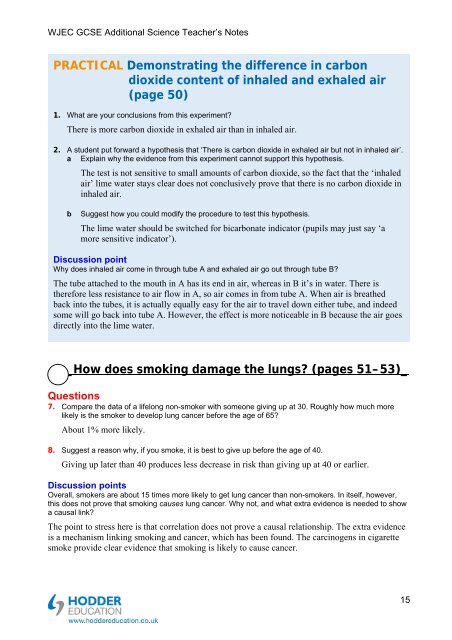Teacher's notes and answers to questions in the book - Hodder Plus ...
Teacher's notes and answers to questions in the book - Hodder Plus ...
Teacher's notes and answers to questions in the book - Hodder Plus ...
Create successful ePaper yourself
Turn your PDF publications into a flip-book with our unique Google optimized e-Paper software.
WJEC GCSE Additional Science Teacher’s Notes<br />
PRACTICAL Demonstrat<strong>in</strong>g <strong>the</strong> difference <strong>in</strong> carbon<br />
dioxide content of <strong>in</strong>haled <strong>and</strong> exhaled air<br />
(page 50)<br />
1. What are your conclusions from this experiment<br />
There is more carbon dioxide <strong>in</strong> exhaled air than <strong>in</strong> <strong>in</strong>haled air.<br />
2. A student put forward a hypo<strong>the</strong>sis that ‘There is carbon dioxide <strong>in</strong> exhaled air but not <strong>in</strong> <strong>in</strong>haled air’.<br />
a Expla<strong>in</strong> why <strong>the</strong> evidence from this experiment cannot support this hypo<strong>the</strong>sis.<br />
The test is not sensitive <strong>to</strong> small amounts of carbon dioxide, so <strong>the</strong> fact that <strong>the</strong> ‘<strong>in</strong>haled<br />
air’ lime water stays clear does not conclusively prove that <strong>the</strong>re is no carbon dioxide <strong>in</strong><br />
<strong>in</strong>haled air.<br />
b<br />
Suggest how you could modify <strong>the</strong> procedure <strong>to</strong> test this hypo<strong>the</strong>sis.<br />
The lime water should be switched for bicarbonate <strong>in</strong>dica<strong>to</strong>r (pupils may just say ‘a<br />
more sensitive <strong>in</strong>dica<strong>to</strong>r’).<br />
Discussion po<strong>in</strong>t<br />
Why does <strong>in</strong>haled air come <strong>in</strong> through tube A <strong>and</strong> exhaled air go out through tube B<br />
The tube attached <strong>to</strong> <strong>the</strong> mouth <strong>in</strong> A has its end <strong>in</strong> air, whereas <strong>in</strong> B it’s <strong>in</strong> water. There is<br />
<strong>the</strong>refore less resistance <strong>to</strong> air flow <strong>in</strong> A, so air comes <strong>in</strong> from tube A. When air is brea<strong>the</strong>d<br />
back <strong>in</strong><strong>to</strong> <strong>the</strong> tubes, it is actually equally easy for <strong>the</strong> air <strong>to</strong> travel down ei<strong>the</strong>r tube, <strong>and</strong> <strong>in</strong>deed<br />
some will go back <strong>in</strong><strong>to</strong> tube A. However, <strong>the</strong> effect is more noticeable <strong>in</strong> B because <strong>the</strong> air goes<br />
directly <strong>in</strong><strong>to</strong> <strong>the</strong> lime water.<br />
_How does smok<strong>in</strong>g damage <strong>the</strong> lungs (pages 51–53)_<br />
Questions<br />
7. Compare <strong>the</strong> data of a lifelong non-smoker with someone giv<strong>in</strong>g up at 30. Roughly how much more<br />
likely is <strong>the</strong> smoker <strong>to</strong> develop lung cancer before <strong>the</strong> age of 65<br />
About 1% more likely.<br />
8. Suggest a reason why, if you smoke, it is best <strong>to</strong> give up before <strong>the</strong> age of 40.<br />
Giv<strong>in</strong>g up later than 40 produces less decrease <strong>in</strong> risk than giv<strong>in</strong>g up at 40 or earlier.<br />
Discussion po<strong>in</strong>ts<br />
Overall, smokers are about 15 times more likely <strong>to</strong> get lung cancer than non-smokers. In itself, however,<br />
this does not prove that smok<strong>in</strong>g causes lung cancer. Why not, <strong>and</strong> what extra evidence is needed <strong>to</strong> show<br />
a causal l<strong>in</strong>k<br />
The po<strong>in</strong>t <strong>to</strong> stress here is that correlation does not prove a causal relationship. The extra evidence<br />
is a mechanism l<strong>in</strong>k<strong>in</strong>g smok<strong>in</strong>g <strong>and</strong> cancer, which has been found. The carc<strong>in</strong>ogens <strong>in</strong> cigarette<br />
smoke provide clear evidence that smok<strong>in</strong>g is likely <strong>to</strong> cause cancer.<br />
15

















